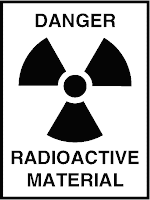 When US Person served in the Jimmy Carter administration, one of the solutions to the nuclear waste problem considered and rejected was the reprocessing of spent nuclear fuel. President Carter was the commander of a nuclear submarine prior to entering politics. He was a peanut farmer who understood the nuclear fuel cycle. Then, reprocessing was rejected as unfeasible primarily for security reasons since reprocessing extracts the 1% of nuclear fuel that is recyclable, plutonium[1]. Plutonium is a highly toxic nuclear fuel used in making weapons. Less than 20 pounds of plutonium is needed to make a nuclear weapon. If plutonium were to get into the hands of terrorists or an unfriendly dictator, the United States would face a considerable security problem. The previous administration recognized that a U.S. reprocessing program would add to the worldwide stockpile of plutonium. According to the Union of Concerned Scientists, roughly 240 metric tons is stored as of 2003. That amount would increase by more than 500 metric tons if the U.S. reprocessed spent fuel generated to date (2006). A plant big enough to handle the amount of spent fuel waste generated in the United States could cost between $7.5 billion to $30 billion to build. That estimate excludes annual operation costs. A second facility would be needed to reprocess spent fuel over a period of some thirty years.[2]
When US Person served in the Jimmy Carter administration, one of the solutions to the nuclear waste problem considered and rejected was the reprocessing of spent nuclear fuel. President Carter was the commander of a nuclear submarine prior to entering politics. He was a peanut farmer who understood the nuclear fuel cycle. Then, reprocessing was rejected as unfeasible primarily for security reasons since reprocessing extracts the 1% of nuclear fuel that is recyclable, plutonium[1]. Plutonium is a highly toxic nuclear fuel used in making weapons. Less than 20 pounds of plutonium is needed to make a nuclear weapon. If plutonium were to get into the hands of terrorists or an unfriendly dictator, the United States would face a considerable security problem. The previous administration recognized that a U.S. reprocessing program would add to the worldwide stockpile of plutonium. According to the Union of Concerned Scientists, roughly 240 metric tons is stored as of 2003. That amount would increase by more than 500 metric tons if the U.S. reprocessed spent fuel generated to date (2006). A plant big enough to handle the amount of spent fuel waste generated in the United States could cost between $7.5 billion to $30 billion to build. That estimate excludes annual operation costs. A second facility would be needed to reprocess spent fuel over a period of some thirty years.[2]Despite nuclear proliferation, cost and contamination concerns, an acting assistant secretary of the Department of Energy urged members of the nuclear industry at a recent meeting in Georgia to pursue irradiated fuel storage and reprocessing. Whether this statement represents the official position of Team 44 is not yet clear. If nuclear fuel reprocessing is the policy of the current administration, then it ignores the unencouraging experience of other countries, notably France, which generates most of its electricity by nuclear power[3]. Contrary to claims, the reprocessing of spent nuclear fuel does not "close the nuclear fuel cycle", but produces its own highly contaminated waste streams[4]. At its La Hague plant between 1976 and the end of 2006, France has reprocessed about 23,000 metric tons of light water reactor (LWR) fuel. The state electric utility has a backlog of some 12,000 tons of spent fuel. A 2001 economic report for the Prime Minister concluded that the decision to reprocess fuel instead of direct storage of fuel wastes for the entire French nuclear power program (58 pressurized water reactors as of 2007) would increase waste management costs by 85%. The separation of plutonium and re-enrichment of uranium are both uneconomic activities even in France which has granted most favorable political and industrial conditions to the industry. Despite no dramatic reduction in the radioactive waste stream--a major argument for reprocessing--France intends to continue reprocessing 850 tons of the 1200 tons produced annually at La Hague. Commercial reprocessing ended in 1997 at the only other reprocessing facility, Marcoule. La Hague has official permission to discharge very large amounts of radioactivity into the environment. The plant is currently the largest man-made source of radioactivity releases to the global environment[5]. Theoretically, at current levels, La Hague will emit enough radioactive discharges over its remaining life to cause 3000 additional cancer deaths worldwide. Virtually all European nations have halted plans to reprocess nuclear fuel. The sole exception, the U.K., intends to end reprocessing within the next decade. Nuclear proliferation is still a problem today and a valid reason to reject reprocessing. The current administration claims it is seeking green solutions to America's foreign energy dependence and climate change, but reprocessing creates more problems than it solves. More reasons to just say no.
[1]Attempts to recycle uranium during the Cold War resulted in catastrophic contamination of reprocessing equipment and workers
www.washingtonpost.com/wp-srv/national/daily/sept99/paducah21.htm; see also www.fpif.org/fpiftxt/5351
[2]/www.ucsusa.org/assets/documents/nuclear_power/nuclear-reprocessing-factsheet.pdf
[3] www.fissilematerials.org/ipfm/site_down/rr04.pdf
[4] According to the International Panel on Fissile Materials an independent group of arms-control and nonproliferation experts, reprocessing "definitely makes waste management more complex qualitatively". There are the wastes of reprocessing itself --high level vitrified waste, intermediate structural wastes from LWR assemblies and intermediate process waste such as sludge from liquid effluent treatment--and new irradiated materials from fuel fabrication and uranium re-enrichment processes. Id.
[5] Id. at 41.